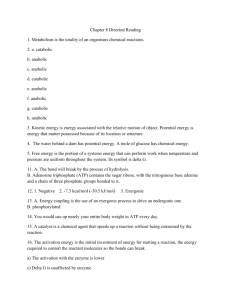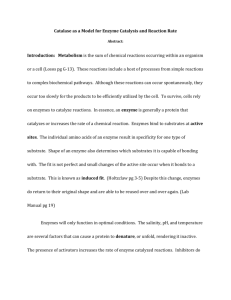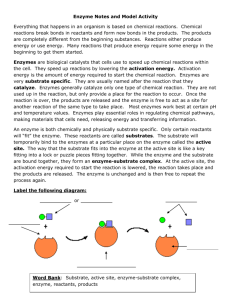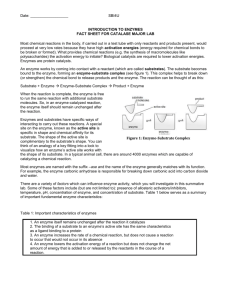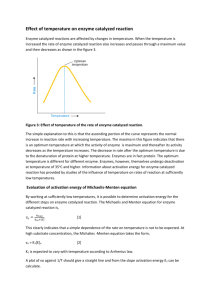Lecture 5 - Andrew.cmu.edu
advertisement
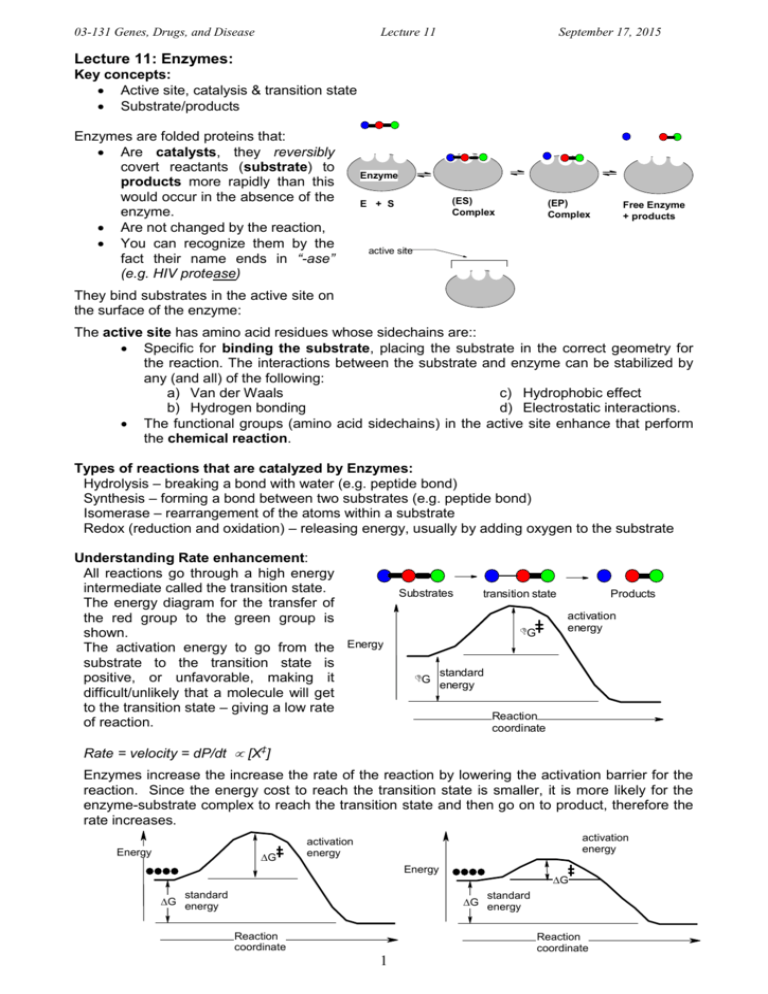
03-131 Genes, Drugs, and Disease Lecture 11 September 17, 2015 Lecture 11: Enzymes: Key concepts: Active site, catalysis & transition state Substrate/products Enzymes are folded proteins that: Are catalysts, they reversibly covert reactants (substrate) to products more rapidly than this would occur in the absence of the enzyme. Are not changed by the reaction, You can recognize them by the fact their name ends in “-ase” (e.g. HIV protease) Enzyme (ES) Complex E + S (EP) Complex Free Enzyme + products active site They bind substrates in the active site on the surface of the enzyme: The active site has amino acid residues whose sidechains are:: Specific for binding the substrate, placing the substrate in the correct geometry for the reaction. The interactions between the substrate and enzyme can be stabilized by any (and all) of the following: a) Van der Waals c) Hydrophobic effect b) Hydrogen bonding d) Electrostatic interactions. The functional groups (amino acid sidechains) in the active site enhance that perform the chemical reaction. Types of reactions that are catalyzed by Enzymes: Hydrolysis – breaking a bond with water (e.g. peptide bond) Synthesis – forming a bond between two substrates (e.g. peptide bond) Isomerase – rearrangement of the atoms within a substrate Redox (reduction and oxidation) – releasing energy, usually by adding oxygen to the substrate Understanding Rate enhancement: All reactions go through a high energy intermediate called the transition state. The energy diagram for the transfer of the red group to the green group is shown. The activation energy to go from the Energy substrate to the transition state is positive, or unfavorable, making it difficult/unlikely that a molecule will get to the transition state – giving a low rate of reaction. Substrates transition state Products activation energy G G standard energy Reaction coordinate Rate = velocity = dP/dt [X‡] Enzymes increase the increase the rate of the reaction by lowering the activation barrier for the reaction. Since the energy cost to reach the transition state is smaller, it is more likely for the enzyme-substrate complex to reach the transition state and then go on to product, therefore the rate increases. Energy G activation energy activation energy Energy standard G energy G standard G energy Reaction coordinate Reaction coordinate 1 03-131 Genes, Drugs, and Disease Lecture 11 September 17, 2015 Basis of the Rate Enhancement (why the activation energy is lowered): Most reactions require that molecules interact Uncatalyzed reaction in a productive way. For example the transfer of the red group to the green requires the two substrates to become close to each other, or ordered. This requires ordering of the system, or a decrease in entropy – which is unfavorable. Enzyme catalyzed reaction Enzymes, because they will pre-order the substrates by binding to them, will reduce the activation energy because there is no additional ordering required to go to the transition state. Enzyme Key Point: The most common way by which enzymes decrease the energy of the transition state is by pre-ordering the reactants (as well as functional groups on the enzyme), thus the avoiding the unfavorable decrease in order (entropy) that occurs in the uncatalyzed reaction. Effect of Substrate Concentration on Rate: The rate of a reaction is the amount of product formed/unit time Rate = velocity = products/time = d[P]/dt [ES] As the substrate concentration increases, so Rate does the rate, because more (ES) complex is of formed. Eventually the rate reaches a maximum, Reaction when all the enzyme is in the (ES) form. The enzyme is saturated with substrate. [S] E + S (ES) (EP) E + P Environmental Effects on enzyme activity: Temperature: The High Temperature rates increase with Low Temperature activation activation temperature energy energy Energy Energy because the G G concentration of standard standard the transition state G energy G energy increases with Reaction Reaction temperature (until coordinate coordinate the protein unfolds.) The optimal temperature of an enzyme often depends on the growth temperature of an organism. Organisms that live at high temperatures (thermophiles) often have thermostable enzymes. pH: The ionization state of sidechains in the active site can affect activity, e.g HIV protease. 2

